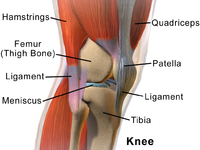
Photo from wikipedia
&NA; The purpose of this study was to study the clinical and radiographic changes in the knee after arthroscopic partial meniscectomy (APM) at a long‐term follow‐up compared with the contralateral… Click to show full abstract
&NA; The purpose of this study was to study the clinical and radiographic changes in the knee after arthroscopic partial meniscectomy (APM) at a long‐term follow‐up compared with the contralateral knee. We assessed 57 patients (38 males and 19 females) with pre‐ and postoperative weight‐bearing radiography with a follow‐up ranging from 5.1 to 12.1 years (mean: 8.1) to analyze prevalence and progression of knee osteoarthritis (OA) after APM. We stratified patients according to body mass index (BMI), type of lesion (degenerative vs. traumatic), and side of meniscectomy (medial, lateral, and medial plus lateral). Patients were evaluated both clinically with Knee Osteoarthritis Outcome Score (KOOS) and Western Ontario and McMaster Universities Osteoarthritis Index (WOMAC) score and radiographically with the Kellgren and Lawrence (K/L) score. Radiographic OA was defined as K/L grade 2 or worse. The prevalence of knee OA was 62.69% in the tibiofemoral compartment. The progression of knee OA was statistically significant, ranging from 17.2% preoperatively to 65.95% postoperatively (p = 0.001) in the medial compartment and from 17.64% preoperatively to 58.82% postoperatively (p = 0.0324) in the lateral compartment. The progression of knee OA in the patellofemoral compartment ranged from 5.26 to 42.10% (p = 0.001). The OA progression regarding BMI was higher into the obese group than the normal‐weight group and greater in the degenerative group than the traumatic one. The mean KOOS was 72.01 and the mean WOMAC was 73.84. The Spearman's test showed a statistical significance between clinical and radiographic results. Patients in the obese, overweight, and degenerative tear group had a greater predisposition to OA in the tibiofemoral and patellofemoral compartments after meniscectomy. The level of evidence is III, retrospective study.
Journal Title: Journal of Knee Surgery
Year Published: 2019
Link to full text (if available)
Share on Social Media: Sign Up to like & get
recommendations!